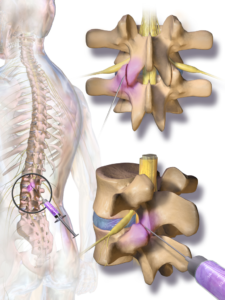
Facet joint injections are used to relieve back and neck pain that occurs with facet joint inflammation. However, the pain relief does not last long and is only effective in fifty percent of patients.
What is it?
Facet joints are tiny joints along the spine the help provide stability to the skeletal system. Sometimes, these joints can become painful due to either back injuries or chronic conditions, such as spinal arthritis. A facet joint injection can be performed to help relieve pain. During an injection, a small amount of local anesthetic and steroid medication will be administered to numb and block pain receptors in the joint area. These injections are intended to reduce pain to the extent that a patient can more comfortably endure physical therapy to rehabilitate adequately from their condition.
What should I do to prepare?
You should not eat or drink a certain amount of time (around eight hours) before the procedure. Inform your doctor of any medications you take to see if you can continue taking them before the procedure. You should arrange for transportation home afterward.
What happens during the process?
Using a Fluoroscopic X-Ray, physicians can identify and target the specific joints causing them pain. Initially, a local anesthetic is applied so that the patient is numbed for the procedure. Once the area is numbed, a small needle is inserted into the spine. An anesthetic and a corticosteroid anti-inflammatory are injected. After these injections, the patient should feel immediate pain relief. This procedure takes approximately 20-30 minutes and is performed on an outpatient basis, typically no more than three times within a six-month period.
What are the risks and potential complications?
There are possible risks following a facet joint injection. However, the complication rates from this procedure, in particular, are minuscule. They can include allergic reactions to the x-ray contrast or steroid, bleeding, usually only in those with underlying bleeding disorders, minor discomfort at the injection site, and spinal cord damage or paralysis, although this is extremely rare. In conjunction with these common side effects, some rare side effects are observed in patients resulting from steroid medication. These can include hot flashes for several days, fluid retention, weight gain, increased appetite, high blood pressure, mood swings and irritability, anxiety, difficulty sleeping, high blood sugar, and a decrease in immunity.
Disclaimer:
All GlobeHealer Site content, including graphics, images, logos, and text, among other materials on the site are for educational purposes only. This content is not intended to be a substitute for professional medical advice, and you should always contact your physician or qualified health provider for information regarding your health. Information on this site regarding the overview, diagnosis, and treatment of any kind should be looked at, in addition to the advice and information of your health care professional. Do not disregard medical advice or delay seeking treatment or medical advice due to information found on the GlobeHealer site.
If there is even the possibility that you may have a medical emergency, seek treatment, call your doctor, or call your local emergency telephone number immediately. GlobeHealer does not endorse being the first line of communication in case of emergency and does not endorse any specific test, physician, facility, product, procedure, opinion, or other information that is or may be mentioned on this site or affiliated entities. Reliance of any and all information provided by GlobeHealer, its employees, affiliations, others appearing on the Site under the invitation of GlobeHealer, or visitors of the site is solely at your own risk and is not the responsibility of GlobeHealer.
Image Source: https://upload.wikimedia.org/wikipedia/commons/e/e2/Blausen_0391_FacetJointInjection.png
